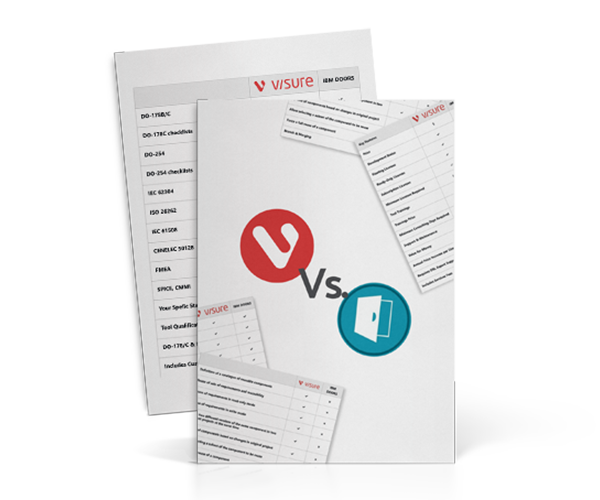IBM Rational DOORS Software Overview | Complete Guide
Why You Should Migrate From DOORS to DOORS Next Generation?
Table of Contents
What is IBM DOORS? What are its Pros and Cons?
IBM DOORS (Dynamic Object-Oriented Requirements System) is a requirements management software tool developed by IBM. It is designed to help organizations capture, manage, and trace requirements throughout the software development life cycle. Here are some of the main pros and cons of using IBM DOORS:
Pros:
- Powerful Features: DOORS offers a wide range of features and capabilities for requirements management, including traceability, baselining, and change management.
- Industry Standard: DOORS is widely used in many industries, including aerospace, defense, automotive, and medical devices, and is often required for compliance with industry standards and regulations.
- Large User Community: DOORS has a large and active user community, which can provide support, advice, and best practices for using the tool effectively.
- Customizable: DOORS can be customized to meet the specific requirements and workflows of different organizations and projects.
Cons:
- Steep Learning Curve: DOORS can be complex and difficult to learn, especially for users who are new to the tool or to requirements engineering in general.
- Outdated User Interface: DOORS has an outdated and somewhat clunky user interface that can be difficult to navigate and use.
- Limited Collaboration Features: DOORS has limited collaboration features, which can make it difficult for team members to work together effectively.
- High Cost: DOORS can be expensive to purchase and maintain, especially for small and medium-sized organizations.
What is DOORS Next Generation? What are its Pros and Cons?
DOORS Next Generation (DNG) is the successor to IBM DOORS and is a web-based requirements management tool designed to help organizations capture, manage, and trace requirements throughout the software development life cycle. Here are some of the main pros and cons of using DOORS Next Generation:
Pros:
- Web-based Interface: DOORS Next Generation has a modern, web-based interface that is more user-friendly and easier to navigate than the interface of its predecessor.
- Improved Collaboration Features: DOORS Next Generation has improved collaboration features that make it easier for team members to work together effectively, including real-time commenting, activity feeds, and team planning.
- Scalability: DOORS Next Generation can handle large and complex projects, and they can be customized to meet the specific requirements and workflows of different organizations and projects.
- Integration: DOORS Next Generation can be integrated with other tools and systems, including IBM’s Rational Team Concert (RTC) and IBM Engineering Lifecycle Management (ELM).
Cons:
- Steep Learning Curve: DOORS Next Generation can still be complex and difficult to learn, especially for users who are new to the tool or to requirements engineering in general.
- Customization: Customizing DOORS Next Generation can be complex and may require technical expertise.
- Limited Support For Legacy DOORS Data: DOORS Next Generation has limited support for legacy DOORS data, which can make migration from DOORS to DNG more difficult.
- High Cost: DOORS Next Generation can be expensive to purchase and maintain, especially for small and medium-sized organizations.
Why you should Migrate from DOORS to DOORS Next Generation?
There are several reasons why you might consider migrating from IBM DOORS to DOORS Next Generation (DNG). Here are some of the main benefits:
- Modern User Interface: DNG has a more modern and intuitive user interface that is easier to use and navigate than the older DOORS interface.
- Enhanced Collaboration: DNG offers improved collaboration features that enable better communication and cooperation among team members, leading to better teamwork and project outcomes.
- Improved Scalability: DNG is built on a modern technology stack that allows it to handle larger and more complex projects, making it a better choice for organizations with more demanding requirements.
- Integration With Other Tools: DNG integrates more easily with other software tools, enabling better interoperability and data sharing across different applications.
- Improved Performance: DNG is faster and more responsive than DOORS, which can help improve productivity and reduce the time required to complete projects.
Overall, migrating from DOORS to DNG can help you improve the efficiency and effectiveness of your requirements management processes, while also providing a more modern and scalable platform for future growth.
Don’t forget to share this post!
Start Gaining End-to-End Traceability Across Your Projects with Visure Today
Start 30-day Free Trial Today!
